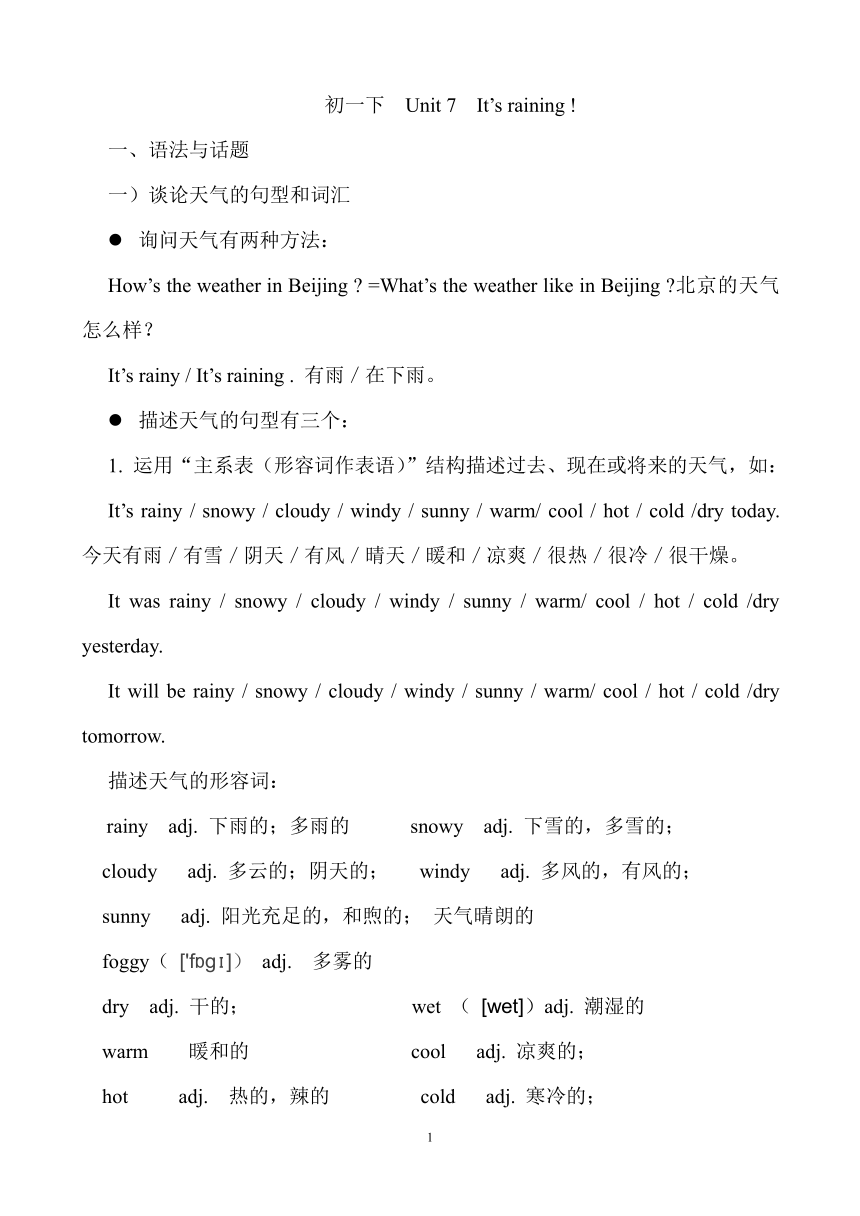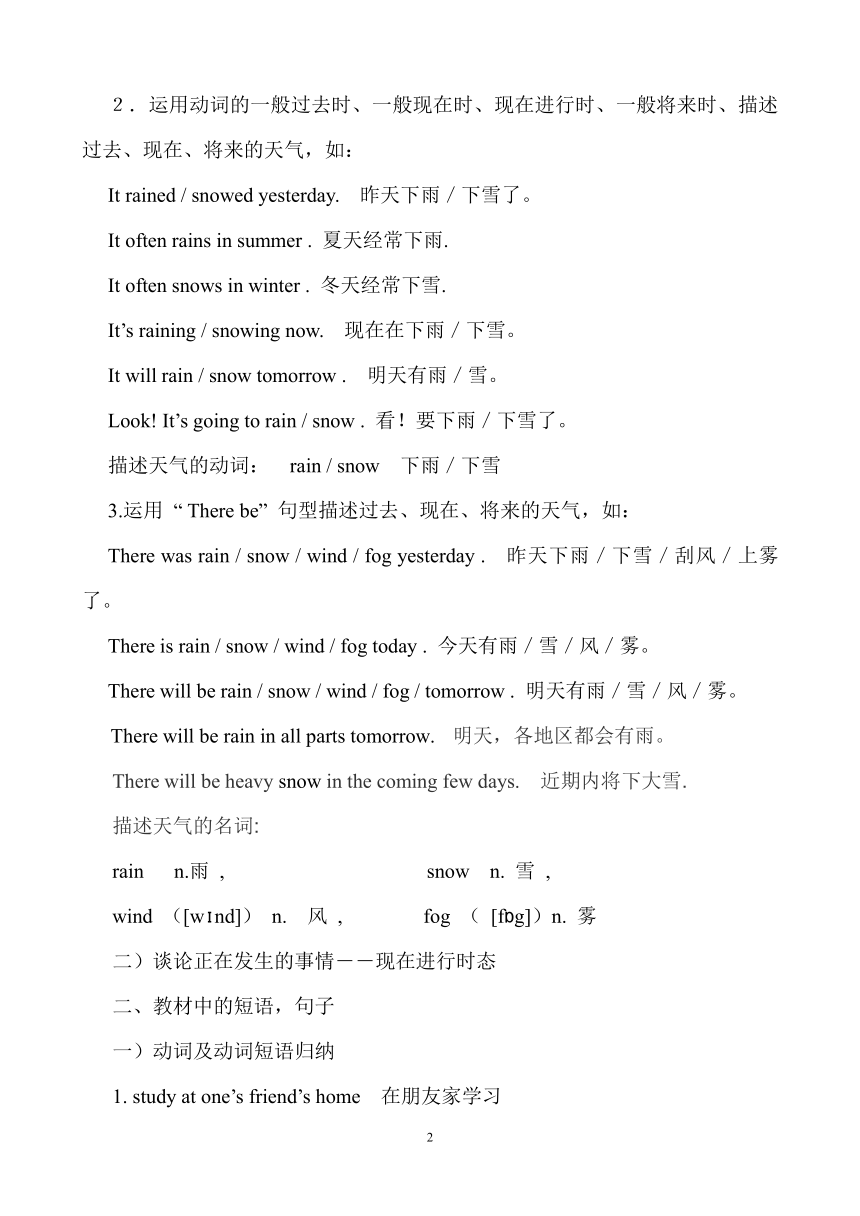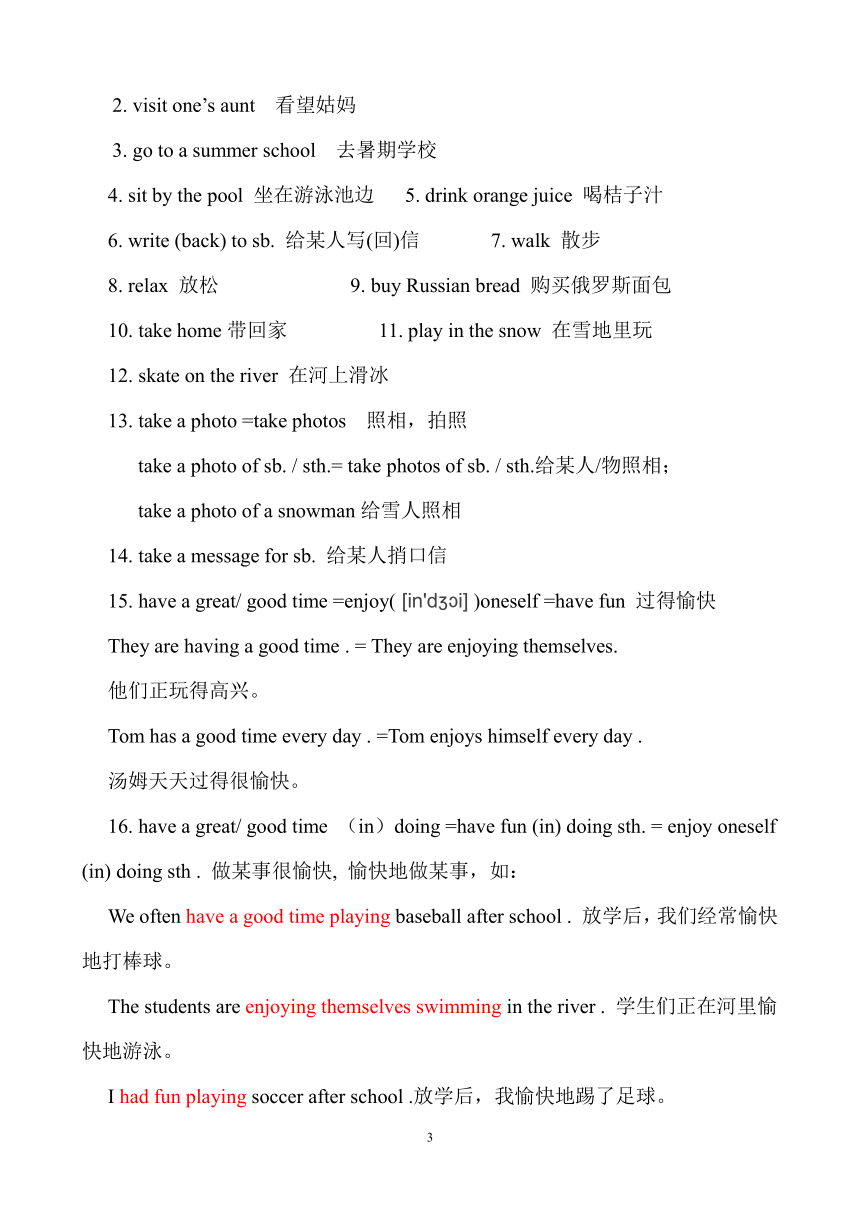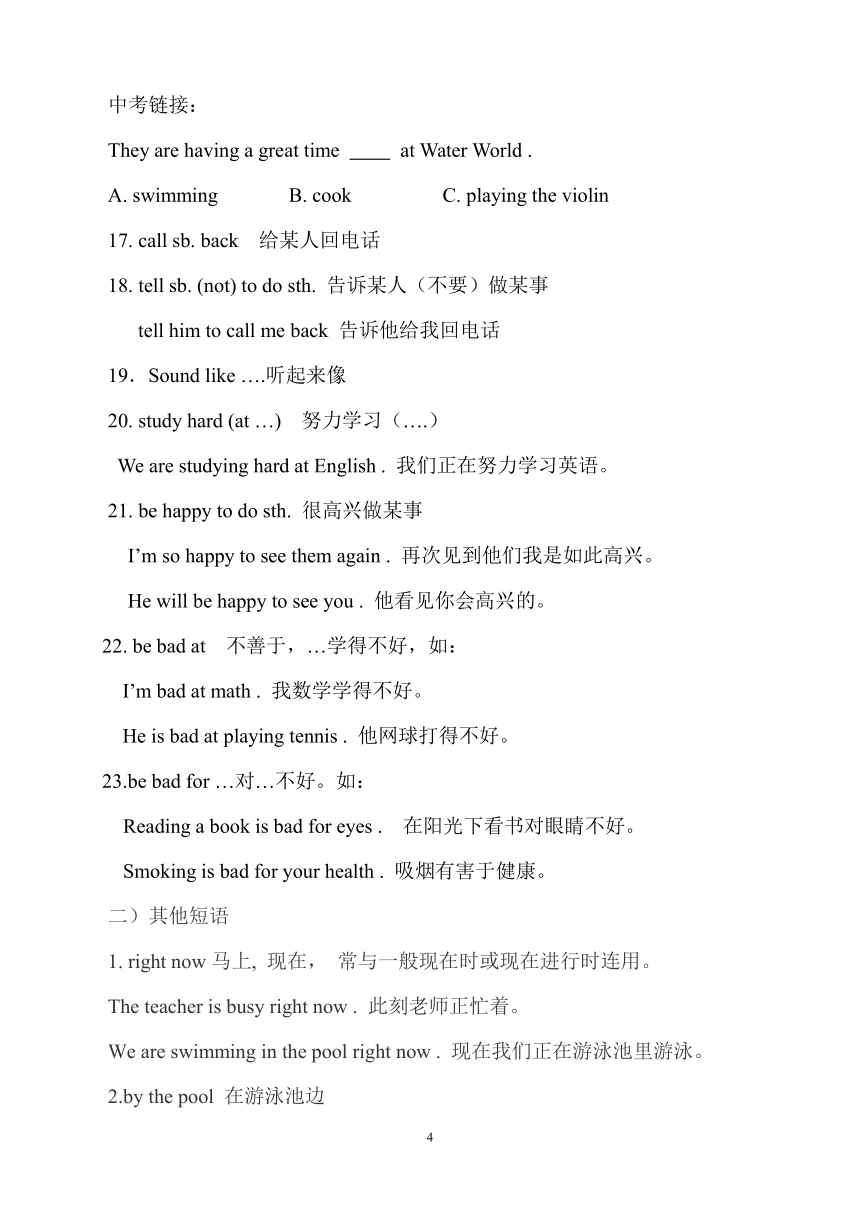Unit 7 It’s raining!同步讲解
文档属性
| 名称 | Unit 7 It’s raining!同步讲解 |  | |
| 格式 | zip | ||
| 文件大小 | 17.4KB | ||
| 资源类型 | 教案 | ||
| 版本资源 | 人教新目标(Go for it)版 | ||
| 科目 | 英语 | ||
| 更新时间 | 2013-12-22 22:06:56 | ||
图片预览





文档简介
初一下 Unit 7 It’s raining !
一、语法与话题
一)谈论天气的句型和词汇
询问天气有两种方法:
How’s the weather in Beijing =What’s the weather like in Beijing 北京的天气怎么样?
It’s rainy / It’s raining . 有雨/在下雨。
描述天气的句型有三个:
1. 运用“主系表(形容词作表语)”结构描述过去、现在或将来的天气,如:
It’s rainy / snowy / cloudy / windy / sunny / warm/ cool / hot / cold /dry today. 今天有雨/有雪/阴天/有风/晴天/暖和/凉爽/很热/很冷/很干燥。
It was rainy / snowy / cloudy / windy / sunny / warm/ cool / hot / cold /dry yesterday.
It will be rainy / snowy / cloudy / windy / sunny / warm/ cool / hot / cold /dry tomorrow.
描述天气的形容词:
rainy adj. 下雨的;多雨的 snowy adj. 下雪的,多雪的;
cloudy adj. 多云的;阴天的; windy adj. 多风的,有风的;
sunny adj. 阳光充足的,和煦的; 天气晴朗的
foggy( ['f g ]) adj. 多雾的
dry adj. 干的; wet ( [wet])adj. 潮湿的
warm 暖和的 cool adj. 凉爽的;
hot adj. 热的,辣的 cold adj. 寒冷的;
2.运用动词的一般过去时、一般现在时、现在进行时、一般将来时、描述过去、现在、将来的天气,如:
It rained / snowed yesterday. 昨天下雨/下雪了。
It often rains in summer . 夏天经常下雨.
It often snows in winter . 冬天经常下雪.
It’s raining / snowing now. 现在在下雨/下雪。
It will rain / snow tomorrow . 明天有雨/雪。
Look! It’s going to rain / snow . 看!要下雨/下雪了。
描述天气的动词: rain / snow 下雨/下雪
3.运用 “ There be” 句型描述过去、现在、将来的天气,如:
There was rain / snow / wind / fog yesterday . 昨天下雨/下雪/刮风/上雾了。
There is rain / snow / wind / fog today . 今天有雨/雪/风/雾。
There will be rain / snow / wind / fog / tomorrow . 明天有雨/雪/风/雾。
There will be rain in all parts tomorrow. ( javascript:;" \o "机器发音 ) 明天,各地区都会有雨。
There will be heavy snow in the coming few days. ( javascript:;" \o "机器发音 ) 近期内将下大雪.
描述天气的名词:
rain n.雨 , snow n. 雪 ,
wind ([w nd]) n. 风 , fog ( [f g])n. 雾
二)谈论正在发生的事情――现在进行时态
二、教材中的短语,句子
一)动词及动词短语归纳
1. study at one’s friend’s home 在朋友家学习
2. visit one’s aunt 看望姑妈
3. go to a summer school 去暑期学校
4. sit by the pool 坐在游泳池边 5. drink orange juice 喝桔子汁
6. write (back) to sb. 给某人写(回)信 7. walk 散步
8. relax 放松 9. buy Russian bread 购买俄罗斯面包
10. take home带回家 11. play in the snow 在雪地里玩
12. skate on the river 在河上滑冰
13. take a photo =take photos 照相,拍照
take a photo of sb. / sth.= take photos of sb. / sth.给某人/物照相;
take a photo of a snowman给雪人照相
14. take a message for sb. 给某人捎口信
15. have a great/ good time =enjoy( [in'd i] )oneself =have fun 过得愉快
They are having a good time . = They are enjoying themselves.
他们正玩得高兴。
Tom has a good time every day . =Tom enjoys himself every day .
汤姆天天过得很愉快。
16. have a great/ good time (in)doing =have fun (in) doing sth. = enjoy oneself (in) doing sth . 做某事很愉快, 愉快地做某事,如:
We often have a good time playing baseball after school . 放学后,我们经常愉快地打棒球。
The students are enjoying themselves swimming in the river . 学生们正在河里愉快地游泳。
I had fun playing soccer after school .放学后,我愉快地踢了足球。
中考链接:
They are having a great time at Water World .
A. swimming B. cook C. playing the violin
17. call sb. back 给某人回电话
18. tell sb. (not) to do sth. 告诉某人(不要)做某事
tell him to call me back 告诉他给我回电话
19.Sound like ….听起来像
20. study hard (at …) 努力学习(….)
We are studying hard at English . 我们正在努力学习英语。
21. be happy to do sth. 很高兴做某事
I’m so happy to see them again . 再次见到他们我是如此高兴。
He will be happy to see you . 他看见你会高兴的。
22. be bad at 不善于,…学得不好,如:
I’m bad at math . 我数学学得不好。
He is bad at playing tennis . 他网球打得不好。
23.be bad for …对…不好。如:
Reading a book is bad for eyes . 在阳光下看书对眼睛不好。
Smoking is bad for your health . 吸烟有害于健康。
二)其他短语
1. right now马上, 现在, 常与一般现在时或现在进行时连用。
The teacher is busy right now . 此刻老师正忙着。
We are swimming in the pool right now . 现在我们正在游泳池里游泳。
2.by the pool 在游泳池边
3. (be ) on a vacation =(be) on a holiday 度假
Go on a vacation 去度假
Summer vacation / holidays 暑假
winter vacation / holidays 寒假
We are on a vacation .我们正在度假。
Tom wants to go on a vacation . 汤姆想去度假。
The students are on winter vacation in Beijing now . 学生们正在北京度寒假。
4. in the mountains 在山里
5. in the rainy weather 在雨天
6.some of ….中的一些, of后可接代词宾格形式。当名词前出现了冠词、指示代词或形容词性物主代词时,也可用some of…,如:
Some of them are lazy. 他们当中的一些人很懒惰。
Some of the students study hard . 一些学生学习很努力。
Some of the juice isn’t good . It’s bad for your health . 有些果汁不好。对身体健康有害。
三)打电话用语
1.-- Can I take a message for him 我能给他捎个口信吗
--Yes . Could you just tell him to call me back 可以.请你告诉他给我回电话,好吗
--Sure , no problem . 当然可以,没问题.
Message : 可数名词,常用短语:
take a message for sb. 为某人捎口信
give sb. a message 捎信给某人; leave a message 留口信
I’m sorry , she is out right now. Can I take a message 对不起,她这会儿出去了,我可以捎个口信吗?
Would you like to leave a message 你想留个口信吗?
2. A: Hello . Jenny speaking . 你好.我是Jenny.
B: Hi, Jenny . It’s Steve here. May I speak to Laura , please
你好,Jenny.我是Steve. 让Laura接电话,好吗
A: Sorry , she’s not at home . Can I take a message
对不起,她不在家.我能捎个口信吗
B: Yes . Could you ask her to call me at 8765-4321
可以.请她给我打电话,好吗 电话号是8765-4321.
A: Sure , no problem . 当然可以,没问题.
3. Who’s that (speaking ) 你是谁?
Who’s speaking 谁在讲话?
May / Could I speak to …. 请…接电话好吗?
Is that …(speaking ) 你是…吗?
This is … (speaking ). 我是…
Hold on , please . 请等一会儿。
Hold on for a moment / minute . 请稍等。
四)其他句子
1. ---How’s it going 情况怎么样?/你近来情况怎么样?
---Not bad , thanks . 还不错。
How’s it going 是询问对方处境或事情进展如何的习惯用语,后面可跟介词短语with sb. / sth. , 可与How is eveything 互换。如:
How’s it going with Peter 彼特最近怎么样?
How’s it going with your study 你最近学习怎么样?
回答How’s it going 时,可根据不同情况来回答。
Pretty( ['priti]) good ! 相当不错! Great ! 很好!
Not bad ! 还不错! Just so-so . 马马虎虎。
Terrible ! 太糟糕了。 Everything is going well . 一切进展顺利。
Not bad . 是口语中常用的表达方式,也可以用Not so bad./ Not too bad 等,其主要用法是:
1)用来回答像How are you 这类询问身体状况的问候语,意思是“不错,还行” 。如:
--How are you today 你今天感觉如何?
– Not bad . 还不错。
2)用来含蓄地表示 “很好,不错,还好”。
--How is your English 你英语学的怎么样?
--Not bad . 还好。
--What do you think of the film 你觉得这部电影怎么样?
--Not bad 不错。
中考链接:
--How’s it going --
A. It’s great . B. You are welcome . C. Thanks a lot .
2. Could you just tell him to call me back 你能不能叫他给我回个电话?
1)Could情态动词,意思是“能,可以”,表示请求许可,在语气上比用can委婉客气,回答时用can。
Could I watch TV now
Yes , you can . / Sure .
No, you can’t .
2)与tell有关的常用结构:
tell sb. (not ) to do sth . 告诉某人(不要)做某事
tell sb. sth. 告诉某人某事
tell sb. about sth 告诉某人关于某事
tell stories / a story 讲故事
中考链接:
Teachers always tell me computer games too much .
A. not to play B. to play
C. not play D. plays
3.Sure , no problem . 当然可以,没问题。
1)no problem常用于口语中表示同意或愉快地答应别人的请求,意为“没问题,小事一桩”,如:
--Could you clean the classroom 请你打扫一下教室好吗?
--No problem . 没问题。
2)no problem还可用来回答感谢语,意为“不用谢,别客气,没什么”如:
--Thank you very much . 非常感谢你。
--No problem . 没什么。
3)no problem还可用来回答道歉语,意为“没关系,没什么”,如:
--I’m sorry to trouble you . 对不起,打扰你了。
--No problem .没关系。
4)no problem还可用来表示有能力做某事,意为“没问题,不在话下”,如:
--Can you make soup 你会做汤吗?
--No problem . 当然了。
中考链接:
--Can you help me cook dinner -- . I’m coming .
A. No problem . B. I’m sorry I can’t .
C. Not at all . D. It’s a pleasure .
4. I want to call you but my phone isn’t working . 我想给你打电话,但我的电话现在不能用了。
Work 此处为不及物动词,意为“运转”,如:
My watch can’t / doesn’t work . 我的手表不走了。
This pen doesn’t work . 这支钢笔写不出字了。
5.The weather here is cool and cloudy , just right for walking . 这儿的天气凉爽且多云,很适合散步。
just right for意为“正好适合”,常放在系动词(be, look, sound 等)后作表语, 后面可接名词、代词、动名词,如:
This sweater is just right for you .这件运动服正好适合你。
These books are just right for the students in Grade 7.这些书正好适合七年级的学生。
Today is sunny and cool , just right for playing baseball . 今天天气晴朗而且凉爽,正好适合打棒球。
The skirt looks just right for her . 这条裙子看起来正好适合她.
6.It’s hot in your country now, isn’t it 现在你的国家天气炎热,不是吗?这是一个反意疑问句。
反意疑问句:
用法:反意疑问句表示提出情况或看法,问对方是否同意自己观点的句型。
构成:陈述句+简短问句
五大特点:反意问句五特点,前后谓语正相反(指肯定与否定);
短句not如出现,必须缩写是习惯(短句指后一部分的问句,问句中如果有not,一定要与助动词等缩写在一起);前后主谓人称、时态和数要一致;短句主语代词填(即简短问句的主语必须用代词主格形式);最后一点应注意,回答肯否要一致.
Lucy is a student , isn’t she Yes , she is . / No, she isn’t .
露西是学生,对吗?是的,她是。/不,她不是。
Tom can sing , can’t he Yes , he can . / No, he can’t .
汤姆会唱歌,是吗?是的,他会唱。/不,他不会唱。
The boys like playing basketball , don’t they 男孩子们喜欢打篮球,是吗?
Yes , they do . / No, they don’t . 是的,他们喜欢。/不,他们不喜欢。
You are studying , aren’t you Yes , I am. / No, I’m not .
你在学习,对吗?对,我在学习。/不,我没在学习。
They aren’t here , are they Yes , they are ./ No, they aren’t .
他们没在这里,是吗? 不,他们在这里。/是的,他们不在这里。
The boys don’t have a computer , do they Yes , they do . / No, they don’t .
男孩子们没有电脑,是吗?不,他们有电脑。/是的,他们没电脑。
拓展: 句子的分类 有两种分类方法:
英语句子按照使用目的和交际功能分为五种:
1、陈述句:包括肯定句和否定句;
2、疑问句:包括一般疑问句、特殊疑问句、反意疑问句、选择疑问句和反诘疑问句五种情况
3、祈使句:有肯定和否定两种形式
4、感叹句:一般由what或how 开头。
5、There be 句型
英语句子按照其结构分为简单句、并列句、复合句和并列复合句四种。
三、学会写卡片:注意格式
PAGE
1
一、语法与话题
一)谈论天气的句型和词汇
询问天气有两种方法:
How’s the weather in Beijing =What’s the weather like in Beijing 北京的天气怎么样?
It’s rainy / It’s raining . 有雨/在下雨。
描述天气的句型有三个:
1. 运用“主系表(形容词作表语)”结构描述过去、现在或将来的天气,如:
It’s rainy / snowy / cloudy / windy / sunny / warm/ cool / hot / cold /dry today. 今天有雨/有雪/阴天/有风/晴天/暖和/凉爽/很热/很冷/很干燥。
It was rainy / snowy / cloudy / windy / sunny / warm/ cool / hot / cold /dry yesterday.
It will be rainy / snowy / cloudy / windy / sunny / warm/ cool / hot / cold /dry tomorrow.
描述天气的形容词:
rainy adj. 下雨的;多雨的 snowy adj. 下雪的,多雪的;
cloudy adj. 多云的;阴天的; windy adj. 多风的,有风的;
sunny adj. 阳光充足的,和煦的; 天气晴朗的
foggy( ['f g ]) adj. 多雾的
dry adj. 干的; wet ( [wet])adj. 潮湿的
warm 暖和的 cool adj. 凉爽的;
hot adj. 热的,辣的 cold adj. 寒冷的;
2.运用动词的一般过去时、一般现在时、现在进行时、一般将来时、描述过去、现在、将来的天气,如:
It rained / snowed yesterday. 昨天下雨/下雪了。
It often rains in summer . 夏天经常下雨.
It often snows in winter . 冬天经常下雪.
It’s raining / snowing now. 现在在下雨/下雪。
It will rain / snow tomorrow . 明天有雨/雪。
Look! It’s going to rain / snow . 看!要下雨/下雪了。
描述天气的动词: rain / snow 下雨/下雪
3.运用 “ There be” 句型描述过去、现在、将来的天气,如:
There was rain / snow / wind / fog yesterday . 昨天下雨/下雪/刮风/上雾了。
There is rain / snow / wind / fog today . 今天有雨/雪/风/雾。
There will be rain / snow / wind / fog / tomorrow . 明天有雨/雪/风/雾。
There will be rain in all parts tomorrow. ( javascript:;" \o "机器发音 ) 明天,各地区都会有雨。
There will be heavy snow in the coming few days. ( javascript:;" \o "机器发音 ) 近期内将下大雪.
描述天气的名词:
rain n.雨 , snow n. 雪 ,
wind ([w nd]) n. 风 , fog ( [f g])n. 雾
二)谈论正在发生的事情――现在进行时态
二、教材中的短语,句子
一)动词及动词短语归纳
1. study at one’s friend’s home 在朋友家学习
2. visit one’s aunt 看望姑妈
3. go to a summer school 去暑期学校
4. sit by the pool 坐在游泳池边 5. drink orange juice 喝桔子汁
6. write (back) to sb. 给某人写(回)信 7. walk 散步
8. relax 放松 9. buy Russian bread 购买俄罗斯面包
10. take home带回家 11. play in the snow 在雪地里玩
12. skate on the river 在河上滑冰
13. take a photo =take photos 照相,拍照
take a photo of sb. / sth.= take photos of sb. / sth.给某人/物照相;
take a photo of a snowman给雪人照相
14. take a message for sb. 给某人捎口信
15. have a great/ good time =enjoy( [in'd i] )oneself =have fun 过得愉快
They are having a good time . = They are enjoying themselves.
他们正玩得高兴。
Tom has a good time every day . =Tom enjoys himself every day .
汤姆天天过得很愉快。
16. have a great/ good time (in)doing =have fun (in) doing sth. = enjoy oneself (in) doing sth . 做某事很愉快, 愉快地做某事,如:
We often have a good time playing baseball after school . 放学后,我们经常愉快地打棒球。
The students are enjoying themselves swimming in the river . 学生们正在河里愉快地游泳。
I had fun playing soccer after school .放学后,我愉快地踢了足球。
中考链接:
They are having a great time at Water World .
A. swimming B. cook C. playing the violin
17. call sb. back 给某人回电话
18. tell sb. (not) to do sth. 告诉某人(不要)做某事
tell him to call me back 告诉他给我回电话
19.Sound like ….听起来像
20. study hard (at …) 努力学习(….)
We are studying hard at English . 我们正在努力学习英语。
21. be happy to do sth. 很高兴做某事
I’m so happy to see them again . 再次见到他们我是如此高兴。
He will be happy to see you . 他看见你会高兴的。
22. be bad at 不善于,…学得不好,如:
I’m bad at math . 我数学学得不好。
He is bad at playing tennis . 他网球打得不好。
23.be bad for …对…不好。如:
Reading a book is bad for eyes . 在阳光下看书对眼睛不好。
Smoking is bad for your health . 吸烟有害于健康。
二)其他短语
1. right now马上, 现在, 常与一般现在时或现在进行时连用。
The teacher is busy right now . 此刻老师正忙着。
We are swimming in the pool right now . 现在我们正在游泳池里游泳。
2.by the pool 在游泳池边
3. (be ) on a vacation =(be) on a holiday 度假
Go on a vacation 去度假
Summer vacation / holidays 暑假
winter vacation / holidays 寒假
We are on a vacation .我们正在度假。
Tom wants to go on a vacation . 汤姆想去度假。
The students are on winter vacation in Beijing now . 学生们正在北京度寒假。
4. in the mountains 在山里
5. in the rainy weather 在雨天
6.some of ….中的一些, of后可接代词宾格形式。当名词前出现了冠词、指示代词或形容词性物主代词时,也可用some of…,如:
Some of them are lazy. 他们当中的一些人很懒惰。
Some of the students study hard . 一些学生学习很努力。
Some of the juice isn’t good . It’s bad for your health . 有些果汁不好。对身体健康有害。
三)打电话用语
1.-- Can I take a message for him 我能给他捎个口信吗
--Yes . Could you just tell him to call me back 可以.请你告诉他给我回电话,好吗
--Sure , no problem . 当然可以,没问题.
Message : 可数名词,常用短语:
take a message for sb. 为某人捎口信
give sb. a message 捎信给某人; leave a message 留口信
I’m sorry , she is out right now. Can I take a message 对不起,她这会儿出去了,我可以捎个口信吗?
Would you like to leave a message 你想留个口信吗?
2. A: Hello . Jenny speaking . 你好.我是Jenny.
B: Hi, Jenny . It’s Steve here. May I speak to Laura , please
你好,Jenny.我是Steve. 让Laura接电话,好吗
A: Sorry , she’s not at home . Can I take a message
对不起,她不在家.我能捎个口信吗
B: Yes . Could you ask her to call me at 8765-4321
可以.请她给我打电话,好吗 电话号是8765-4321.
A: Sure , no problem . 当然可以,没问题.
3. Who’s that (speaking ) 你是谁?
Who’s speaking 谁在讲话?
May / Could I speak to …. 请…接电话好吗?
Is that …(speaking ) 你是…吗?
This is … (speaking ). 我是…
Hold on , please . 请等一会儿。
Hold on for a moment / minute . 请稍等。
四)其他句子
1. ---How’s it going 情况怎么样?/你近来情况怎么样?
---Not bad , thanks . 还不错。
How’s it going 是询问对方处境或事情进展如何的习惯用语,后面可跟介词短语with sb. / sth. , 可与How is eveything 互换。如:
How’s it going with Peter 彼特最近怎么样?
How’s it going with your study 你最近学习怎么样?
回答How’s it going 时,可根据不同情况来回答。
Pretty( ['priti]) good ! 相当不错! Great ! 很好!
Not bad ! 还不错! Just so-so . 马马虎虎。
Terrible ! 太糟糕了。 Everything is going well . 一切进展顺利。
Not bad . 是口语中常用的表达方式,也可以用Not so bad./ Not too bad 等,其主要用法是:
1)用来回答像How are you 这类询问身体状况的问候语,意思是“不错,还行” 。如:
--How are you today 你今天感觉如何?
– Not bad . 还不错。
2)用来含蓄地表示 “很好,不错,还好”。
--How is your English 你英语学的怎么样?
--Not bad . 还好。
--What do you think of the film 你觉得这部电影怎么样?
--Not bad 不错。
中考链接:
--How’s it going --
A. It’s great . B. You are welcome . C. Thanks a lot .
2. Could you just tell him to call me back 你能不能叫他给我回个电话?
1)Could情态动词,意思是“能,可以”,表示请求许可,在语气上比用can委婉客气,回答时用can。
Could I watch TV now
Yes , you can . / Sure .
No, you can’t .
2)与tell有关的常用结构:
tell sb. (not ) to do sth . 告诉某人(不要)做某事
tell sb. sth. 告诉某人某事
tell sb. about sth 告诉某人关于某事
tell stories / a story 讲故事
中考链接:
Teachers always tell me computer games too much .
A. not to play B. to play
C. not play D. plays
3.Sure , no problem . 当然可以,没问题。
1)no problem常用于口语中表示同意或愉快地答应别人的请求,意为“没问题,小事一桩”,如:
--Could you clean the classroom 请你打扫一下教室好吗?
--No problem . 没问题。
2)no problem还可用来回答感谢语,意为“不用谢,别客气,没什么”如:
--Thank you very much . 非常感谢你。
--No problem . 没什么。
3)no problem还可用来回答道歉语,意为“没关系,没什么”,如:
--I’m sorry to trouble you . 对不起,打扰你了。
--No problem .没关系。
4)no problem还可用来表示有能力做某事,意为“没问题,不在话下”,如:
--Can you make soup 你会做汤吗?
--No problem . 当然了。
中考链接:
--Can you help me cook dinner -- . I’m coming .
A. No problem . B. I’m sorry I can’t .
C. Not at all . D. It’s a pleasure .
4. I want to call you but my phone isn’t working . 我想给你打电话,但我的电话现在不能用了。
Work 此处为不及物动词,意为“运转”,如:
My watch can’t / doesn’t work . 我的手表不走了。
This pen doesn’t work . 这支钢笔写不出字了。
5.The weather here is cool and cloudy , just right for walking . 这儿的天气凉爽且多云,很适合散步。
just right for意为“正好适合”,常放在系动词(be, look, sound 等)后作表语, 后面可接名词、代词、动名词,如:
This sweater is just right for you .这件运动服正好适合你。
These books are just right for the students in Grade 7.这些书正好适合七年级的学生。
Today is sunny and cool , just right for playing baseball . 今天天气晴朗而且凉爽,正好适合打棒球。
The skirt looks just right for her . 这条裙子看起来正好适合她.
6.It’s hot in your country now, isn’t it 现在你的国家天气炎热,不是吗?这是一个反意疑问句。
反意疑问句:
用法:反意疑问句表示提出情况或看法,问对方是否同意自己观点的句型。
构成:陈述句+简短问句
五大特点:反意问句五特点,前后谓语正相反(指肯定与否定);
短句not如出现,必须缩写是习惯(短句指后一部分的问句,问句中如果有not,一定要与助动词等缩写在一起);前后主谓人称、时态和数要一致;短句主语代词填(即简短问句的主语必须用代词主格形式);最后一点应注意,回答肯否要一致.
Lucy is a student , isn’t she Yes , she is . / No, she isn’t .
露西是学生,对吗?是的,她是。/不,她不是。
Tom can sing , can’t he Yes , he can . / No, he can’t .
汤姆会唱歌,是吗?是的,他会唱。/不,他不会唱。
The boys like playing basketball , don’t they 男孩子们喜欢打篮球,是吗?
Yes , they do . / No, they don’t . 是的,他们喜欢。/不,他们不喜欢。
You are studying , aren’t you Yes , I am. / No, I’m not .
你在学习,对吗?对,我在学习。/不,我没在学习。
They aren’t here , are they Yes , they are ./ No, they aren’t .
他们没在这里,是吗? 不,他们在这里。/是的,他们不在这里。
The boys don’t have a computer , do they Yes , they do . / No, they don’t .
男孩子们没有电脑,是吗?不,他们有电脑。/是的,他们没电脑。
拓展: 句子的分类 有两种分类方法:
英语句子按照使用目的和交际功能分为五种:
1、陈述句:包括肯定句和否定句;
2、疑问句:包括一般疑问句、特殊疑问句、反意疑问句、选择疑问句和反诘疑问句五种情况
3、祈使句:有肯定和否定两种形式
4、感叹句:一般由what或how 开头。
5、There be 句型
英语句子按照其结构分为简单句、并列句、复合句和并列复合句四种。
三、学会写卡片:注意格式
PAGE
1
同课章节目录
- Unit 1 Can you play the guitar?
- Section A
- Section B
- Unit 2 What time do you go to school?
- Section A
- Section B
- Unit 3 How do you get to school?
- Section A
- Section B
- Unit 4 Don't eat in class.
- Section A
- Section B
- Unit 5 Why do you like pandas?
- Section A
- Section B
- Unit 6 I'm watching TV.
- Section A
- Section B
- Review of Units 1-6
- Unit 7 It's raining!
- Section A
- Section B
- Unit 8 Is there a post office near here?
- Section A
- Section B
- Unit 9 What does he look like?
- Section A
- Section B
- Unit 10 I'd like some noodles.
- Section A
- Section B
- Unit 11 How was your school trip?
- Section A
- Section B
- Unit 12 What did you do last weekend?
- Section A
- Section B
